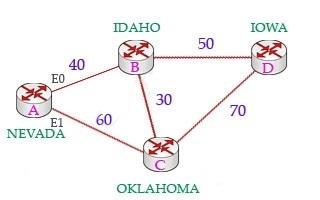Download Cisco.200-301.Lead2Pass.2024-01-15.667q.tqb
| Vendor: | Cisco |
| Exam Code: | 200-301 |
| Exam Name: | Cisco Certified Network Associate (200-301 CCNA) |
| Date: | Jan 15, 2024 |
| File Size: | 41 MB |
| Downloads: | 5 |
Demo Questions
Question 1
Which statement correctly compares traditional networks and controller-based networks?
- Only traditional networks offer a centralized control plane
- Only traditional networks natively support centralized management
- Traditional and controller-based networks abstract policies from device configurations
- Only controller-based networks decouple the control plane and the data plane
Correct answer: D
Explanation:
Most traditional devices use a distributed architecture, in which each control plane is resided in a networking device. Therefore they need to communicate with each other via messages to work correctly.In contrast to distributed architecture, centralized (or controller-based) architectures centralizes the control of networking devices into one device, called SDN controller -> Answer D is correct. Most traditional devices use a distributed architecture, in which each control plane is resided in a networking device. Therefore they need to communicate with each other via messages to work correctly.
In contrast to distributed architecture, centralized (or controller-based) architectures centralizes the control of networking devices into one device, called SDN controller -> Answer D is correct.
Question 2
How does HSRP provide first hop redundancy?
- It load-balances traffic by assigning the same metric value to more than one route to the samedestination in the IP routing table.
- It load-balances Layer 2 traffic along the path by flooding traffic out all interfaces configured withthe same VLAN.
- It forwards multiple packets to the same destination over different routed links in the data path
- It uses a shared virtual MAC and a virtual IP address to a group of routers that serve as thedefault gateway for hosts on a LAN
Correct answer: D
Explanation:
https://www.cisco.com/c/en/us/td/docs/ios-xml/ios/ipapp_fhrp/configuration/xe-16/fhp-xe-16-book/fhp-hsrp-mgo.html https://www.cisco.com/c/en/us/td/docs/ios-xml/ios/ipapp_fhrp/configuration/xe-16/fhp-xe-16-book/fhp-hsrp-mgo.html
Question 3
Which two actions influence the EIGRP route selection process? (Choose two)
- The router calculates the reported distance by multiplying the delay on the exiting Interface by256.
- The router calculates the best backup path to the destination route and assigns it as the feasiblesuccessor.
- The router calculates the feasible distance of all paths to the destination route
- The advertised distance is calculated by a downstream neighbor to inform the local router of thebandwidth on the link
- The router must use the advertised distance as the metric for any given route
Correct answer: BC
Explanation:
The reported distance (or advertised distance) is the cost from the neighbor to the destination. It is calculated from the router advertising the route to the network. For example in the topology below, suppose router A & B are exchanging their routing tables for the first time. Router B says "Hey, the best metric (cost) from me to IOWA is 50 and the metric from you to IOWA is 90" and advertises it to router A.Router A considers the first metric (50) as the Advertised distance. The second metric (90), which is from NEVADA to IOWA (through IDAHO), is called the Feasible distance. The reported distance is calculated in the same way of calculating the metric. By default (K1 = 1, K2 = 0, K3 = 1, K4 = 0, K5 = 0), the metric is calculated as follows: -> Answer A is not correct.Feasible successor is the backup route. To be a feasible successor, the route must have an Advertised distance (AD) less than the Feasible distance (FD) of the current successor route -> Answer B is correct.Feasible distance (FD): The sum of the AD plus the cost between the local router and the next-hop router.The router must calculate the FD of all paths to choose the best path to put into the routing table.Note: Although the new CCNA exam does not have EIGRP topic but you should learn the basic knowledge of this routing protocol. The reported distance (or advertised distance) is the cost from the neighbor to the destination. It is calculated from the router advertising the route to the network. For example in the topology below, suppose router A & B are exchanging their routing tables for the first time. Router B says "Hey, the best metric (cost) from me to IOWA is 50 and the metric from you to IOWA is 90" and advertises it to router A.
Router A considers the first metric (50) as the Advertised distance. The second metric (90), which is from NEVADA to IOWA (through IDAHO), is called the Feasible distance.

The reported distance is calculated in the same way of calculating the metric. By default (K1 = 1, K2 = 0, K3 = 1, K4 = 0, K5 = 0), the metric is calculated as follows:

-> Answer A is not correct.
Feasible successor is the backup route. To be a feasible successor, the route must have an Advertised distance (AD) less than the Feasible distance (FD) of the current successor route -> Answer B is correct.
Feasible distance (FD): The sum of the AD plus the cost between the local router and the next-hop router.
The router must calculate the FD of all paths to choose the best path to put into the routing table.
Note: Although the new CCNA exam does not have EIGRP topic but you should learn the basic knowledge of this routing protocol.






